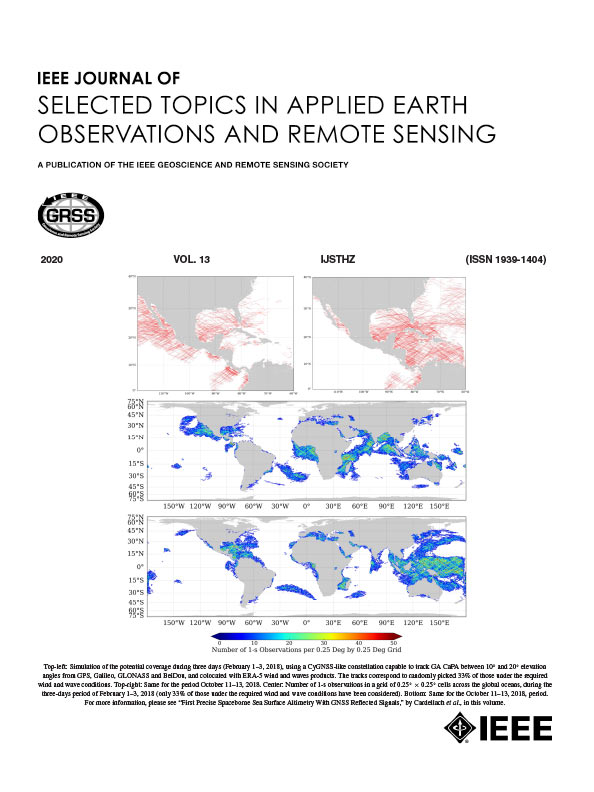利用反向传播神经网络提高Jason-3型PWV产品在沿海地区的精度
IF 4.7
2区 地球科学
Q1 ENGINEERING, ELECTRICAL & ELECTRONIC
IEEE Journal of Selected Topics in Applied Earth Observations and Remote Sensing
Pub Date : 2025-04-16
DOI:10.1109/JSTARS.2025.3559732
引用次数: 0
摘要
高测卫星上的微波辐射计在沿海地区测量水汽的性能由于其足迹内的土地混合而显著下降。在这项研究中,我们提出使用反向传播神经网络(BPNN)模型来提高沿海地区Jason-3可降水量(PWV)的精度。参考的PWV数据来自全球分布的2076个沿海和岛屿全球导航卫星系统(GNSS)站和237个无线电探空站。具体而言,2016年和2017年的GNSS PWV数据用于训练BPNN模型,2018年1月至2023年6月的GNSS和无线电探空PWV观测数据用于测试BPNN模型的性能。结果表明,所提出的BPNN PWV模型可以显著提高Jason-3在沿海地区(距离陆地25公里以内)记录的PWV精度。通过GNSS PWV评估,BPNN模型可以将沿海地区Jason-3 PWV的均方根误差(RMSE)从4.2 kg/m2降低到2.7 kg/m2,减少了35.7%的RMSE。结果表明,采用BPNN模型后,Jason-3在沿海地区的PWV RMSE由5.0 kg/m2降低到3.6 kg/m2 (RMSE降低的28.0%)。本文章由计算机程序翻译,如有差异,请以英文原文为准。
Enhancing the Accuracy of Jason-3 PWV Products Over Coastal Areas Using the Back Propagation Neural Network
The performance of microwave radiometers aboard altimetric satellites in measuring water vapor degrades significantly over coastal areas due to the mixing of land within its footprint. In this study, we propose using the back propagation neural network (BPNN) models to enhance the accuracy of Jason-3 precipitable water vapor (PWV) over coastal areas. PWV data from 2076 globally distributed coastal and island Global Navigation Satellite System (GNSS) stations and 237 radiosonde stations are used as the reference. Specifically, the GNSS PWV data in 2016 and 2017 are used to train the BPNN models, while the GNSS and radiosonde PWV observations from January 2018 to June 2023 are used to test the performances of the BPNN models proposed. Our results show that the proposed BPNN PWV models can considerably enhance the accuracy of Jason-3 PWV recorded in the coastal areas (within 25 km of land). Evaluated by the GNSS PWV, BPNN models can reduce the root mean square error (RMSE) of Jason-3 PWV in the coastal areas from 4.2 to 2.7 kg/m2 (35.7% of RMSE reduction). Assessed by the radiosonde PWV, the results indicate that the RMSE of Jason-3 PWV in the coastal areas is decreased from 5.0 to 3.6 kg/m2 (28.0% of RMSE reduction) after using the proposed BPNN models.
求助全文
通过发布文献求助,成功后即可免费获取论文全文。
去求助
来源期刊
CiteScore
9.30
自引率
10.90%
发文量
563
审稿时长
4.7 months
期刊介绍:
The IEEE Journal of Selected Topics in Applied Earth Observations and Remote Sensing addresses the growing field of applications in Earth observations and remote sensing, and also provides a venue for the rapidly expanding special issues that are being sponsored by the IEEE Geosciences and Remote Sensing Society. The journal draws upon the experience of the highly successful “IEEE Transactions on Geoscience and Remote Sensing” and provide a complementary medium for the wide range of topics in applied earth observations. The ‘Applications’ areas encompasses the societal benefit areas of the Global Earth Observations Systems of Systems (GEOSS) program. Through deliberations over two years, ministers from 50 countries agreed to identify nine areas where Earth observation could positively impact the quality of life and health of their respective countries. Some of these are areas not traditionally addressed in the IEEE context. These include biodiversity, health and climate. Yet it is the skill sets of IEEE members, in areas such as observations, communications, computers, signal processing, standards and ocean engineering, that form the technical underpinnings of GEOSS. Thus, the Journal attracts a broad range of interests that serves both present members in new ways and expands the IEEE visibility into new areas.

 求助内容:
求助内容: 应助结果提醒方式:
应助结果提醒方式:


